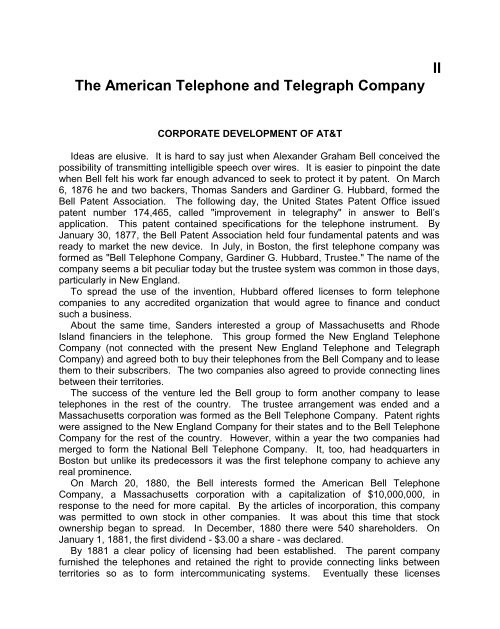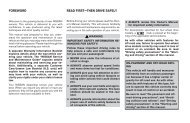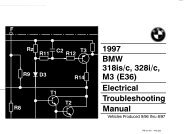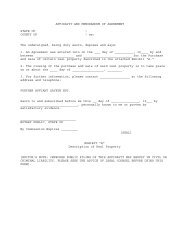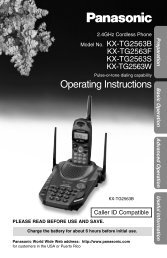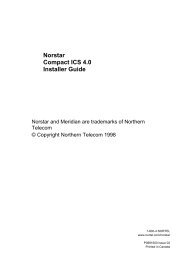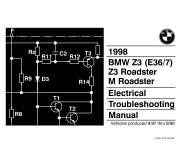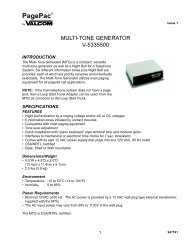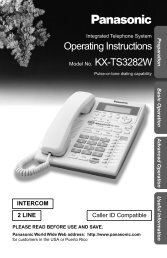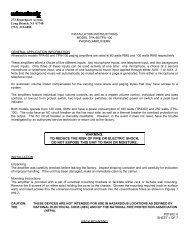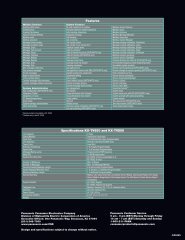The American Telephone <strong>and</strong> Telegraph CompanyIICORPORATE DEVELOPMENT <strong>OF</strong> AT&TIdeas are elusive. It is hard to say just when Alex<strong>and</strong>er Graham <strong>Bell</strong> conceived <strong>the</strong>possibility of transmitting intelligible speech over wires. It is easier to pinpoint <strong>the</strong> datewhen <strong>Bell</strong> felt his work far enough advanced to seek to protect it by patent. On March6, 1876 he <strong>and</strong> two backers, Thomas S<strong>and</strong>ers <strong>and</strong> Gardiner G. Hubbard, formed <strong>the</strong><strong>Bell</strong> Patent Association. The following day, <strong>the</strong> United States Patent Office issuedpatent number 174,465, called "improvement in telegraphy" in answer to <strong>Bell</strong>’sapplication. This patent contained specifications for <strong>the</strong> telephone instrument. ByJanuary 30, 1877, <strong>the</strong> <strong>Bell</strong> Patent Association held four fundamental patents <strong>and</strong> wasready to market <strong>the</strong> new device. In July, in Boston, <strong>the</strong> first telephone company wasformed as "<strong>Bell</strong> Telephone Company, Gardiner G. Hubbard, Trustee." The name of <strong>the</strong>company seems a bit peculiar today but <strong>the</strong> trustee system was common in those days,particularly in New Engl<strong>and</strong>.To spread <strong>the</strong> use of <strong>the</strong> invention, Hubbard offered licenses to form telephonecompanies to any accredited organization that would agree to finance <strong>and</strong> conductsuch a business.About <strong>the</strong> same time, S<strong>and</strong>ers interested a group of Massachusetts <strong>and</strong> RhodeIsl<strong>and</strong> financiers in <strong>the</strong> telephone. This group formed <strong>the</strong> New Engl<strong>and</strong> TelephoneCompany (not connected with <strong>the</strong> present New Engl<strong>and</strong> Telephone <strong>and</strong> TelegraphCompany) <strong>and</strong> agreed both to buy <strong>the</strong>ir telephones from <strong>the</strong> <strong>Bell</strong> Company <strong>and</strong> to lease<strong>the</strong>m to <strong>the</strong>ir subscribers. The two companies also agreed to provide connecting linesbetween <strong>the</strong>ir territories.The success of <strong>the</strong> venture led <strong>the</strong> <strong>Bell</strong> group to form ano<strong>the</strong>r company to leasetelephones in <strong>the</strong> rest of <strong>the</strong> country. The trustee arrangement was ended <strong>and</strong> aMassachusetts corporation was formed as <strong>the</strong> <strong>Bell</strong> Telephone Company. Patent rightswere assigned to <strong>the</strong> New Engl<strong>and</strong> Company for <strong>the</strong>ir states <strong>and</strong> to <strong>the</strong> <strong>Bell</strong> TelephoneCompany for <strong>the</strong> rest of <strong>the</strong> country. However, within a year <strong>the</strong> two companies hadmerged to form <strong>the</strong> National <strong>Bell</strong> Telephone Company. It, too, had headquarters inBoston but unlike its predecessors it was <strong>the</strong> first telephone company to achieve anyreal prominence.On March 20, 1880, <strong>the</strong> <strong>Bell</strong> interests formed <strong>the</strong> American <strong>Bell</strong> TelephoneCompany, a Massachusetts corporation with a capitalization of $10,000,000, inresponse to <strong>the</strong> need for more capital. By <strong>the</strong> articles of incorporation, this companywas permitted to own stock in o<strong>the</strong>r companies. It was about this time that stockownership began to spread. In December, 1880 <strong>the</strong>re were 540 shareholders. OnJanuary 1, 1881, <strong>the</strong> first dividend - $3.00 a share - was declared.By 1881 a clear policy of licensing had been established. The parent companyfurnished <strong>the</strong> telephones <strong>and</strong> retained <strong>the</strong> right to provide connecting links betweenterritories so as to form intercommunicating systems. Eventually <strong>the</strong>se licenses
ecame permanent <strong>and</strong>, in addition to confirming territorial rights, included <strong>the</strong> right toparticipate in all future inventions as well as those existing at <strong>the</strong> time. Each of <strong>the</strong>territorial companies paid rental to <strong>the</strong> parent company <strong>and</strong> <strong>the</strong> parent company wasrepresented in each as a stockholder. Gradually <strong>the</strong> parent company acquiredsubstantial holdings in <strong>the</strong>se companies as a result of providing financial assistance forexpansion.There were now about 300 telephone companies operating under American <strong>Bell</strong>Telephone Company licenses. Many held licenses only for a city. Each operated fairlyindependently, without <strong>the</strong> benefit of knowing how similar problems had been solved ino<strong>the</strong>r locations <strong>and</strong> <strong>the</strong>re was a danger that quality st<strong>and</strong>ards would vary from place toplace. Moreover, <strong>the</strong> growing popularity of <strong>the</strong> telephone indicated that it couldincrease in service greatly through interconnection of exchanges.WESTERN ELECTRIC ENTERS THE BELL SYSTEM<strong>Western</strong> <strong>Electric</strong>’s entry into <strong>the</strong> <strong>Bell</strong> <strong>System</strong> in 1882 provided a source forcompatible telephone equipment of high quality. In 1885 <strong>the</strong> American Telephone <strong>and</strong>Telegraph Company was formed in New York (as a subsidiary of American <strong>Bell</strong>) to build<strong>the</strong> lines needed to connect <strong>the</strong> scattered exchanges "in each <strong>and</strong> every city, town, orplace . . . with one or more points in each <strong>and</strong> every o<strong>the</strong>r city, town, or place ... of <strong>the</strong>United States, <strong>and</strong> in Canada, <strong>and</strong> Mexico . . . <strong>and</strong> also by cable <strong>and</strong> o<strong>the</strong>r appropriatemeans with <strong>the</strong> rest of <strong>the</strong> world." - essentially <strong>the</strong> function now performed by <strong>the</strong> LongLines Department of AT&T.This was <strong>the</strong> goal as stated by Theodore N. Vail, at that time general manager of <strong>the</strong>American <strong>Bell</strong> Telephone Company, <strong>and</strong> subsequently first president of AT&T. Morethan any o<strong>the</strong>r man, Vail was responsible for <strong>the</strong> conception <strong>and</strong> realization of <strong>the</strong> <strong>Bell</strong><strong>System</strong> network. His enthusiasm evoked a predictable response. There were somewho shared his enthusiasm; o<strong>the</strong>rs praised his vision <strong>and</strong> let it go at that; <strong>and</strong> manyo<strong>the</strong>rs shook <strong>the</strong>ir heads in practical disbelief.At <strong>the</strong>ir annual meeting in March, 1900, American <strong>Bell</strong> stockholders voted to makeAT&T <strong>the</strong> central organization of <strong>the</strong> <strong>Bell</strong> <strong>System</strong>. American <strong>Bell</strong> conveyed its assets toAT&T, which served as <strong>the</strong> coordinator of activities among <strong>the</strong> operating companies<strong>and</strong> also retained operation of interconnecting networks.In 1911, AT&T announced its plans to reorganize operating companies into statewideor larger territorial units. "Each associated company . . . will become anautonomous whole, with its own local control <strong>and</strong> identity, <strong>and</strong> within <strong>the</strong> limits of <strong>the</strong>general policy <strong>and</strong> authority, absolute on matters pertaining to or which affect only thatterritory," <strong>the</strong> AT&T annual report stated. This policy continues to guide <strong>Bell</strong> <strong>System</strong>operations today.In December, 1913, AT&T agreed to provide long distance connection of <strong>Bell</strong> <strong>System</strong>lines to <strong>the</strong> numerous independent telephone systems which had developed after <strong>the</strong>expiration of <strong>the</strong> <strong>Bell</strong> Patents. 2 This arrangement contributed to <strong>the</strong> development of <strong>the</strong>entire telephone industry in <strong>the</strong> United States <strong>and</strong> it is because of this access to <strong>the</strong> <strong>Bell</strong><strong>System</strong>’s nation-wide network that each of America’s telephones may be connected toall <strong>the</strong> o<strong>the</strong>rs.
- Page 1 and 2: Western Electricand theBell SystemA
- Page 3 and 4: TABLE OF CONTENTSI The Bell System
- Page 5 and 6: The Bell SystemaConcept in ActionIT
- Page 7: Part I:Our Bell System“Partners
- Page 11 and 12: AT&T’s ROLE IN THE BELL SYSTEMThe
- Page 13 and 14: department sets technical requireme
- Page 15 and 16: OWNERS OF THE BELL SYSTEMSome 2,250
- Page 17 and 18: Bell Telephone LaboratoriesIIIThe g
- Page 19 and 20: the designs and specifications for
- Page 21 and 22: The Bell Telephone CompaniesIVThe c
- Page 23 and 24: operations. How these things are do
- Page 25 and 26: History of Western ElectricVIn Janu
- Page 27 and 28: growing desire by Americans to exhi
- Page 29 and 30: "Nash Fish," for which its inventor
- Page 31 and 32: Less than a year later, in October,
- Page 33 and 34: In the spring of 1946, the first mu
- Page 35 and 36: contributions to this team effort h
- Page 37 and 38: Structure of Western ElectricVIWest
- Page 39 and 40: Long-range planning, for example, b
- Page 41 and 42: company locations except major Work
- Page 43 and 44: defined in their delegations, and m
- Page 45 and 46: Manufacturing-Area AFacilityBALTIMO
- Page 47 and 48: Manufacturing-Area CFacilityALLENTO
- Page 49 and 50: 3. Determine long-range space requi
- Page 51 and 52: HouseInauguratedPennsylvania (forme
- Page 53 and 54: The primary responsibility of an in
- Page 55 and 56: circuits needed in a telephone cent
- Page 57 and 58: Purchasing and TransportationThe Vi
- Page 59 and 60:
The Manager - Plant Design and Cons
- Page 61 and 62:
Organizations Reporting to Assistan
- Page 63 and 64:
Government Sales and Administration
- Page 65 and 66:
Labor CounselThe Labor Counsel deal
- Page 67 and 68:
easonableness of Western’s earnin
- Page 69 and 70:
has primary responsibility for its
- Page 71 and 72:
Principal Subsidiaries of Western E
- Page 73 and 74:
acre site. The company also operate
- Page 75 and 76:
The Manufacturers junction Railway
- Page 77 and 78:
Communications Services and Product
- Page 79 and 80:
these purchases represent a signifi
- Page 81 and 82:
1-S Automatic Call Distributing Sys
- Page 83 and 84:
vertical member in conjunction with
- Page 85 and 86:
dialing area. The extension of dial
- Page 87 and 88:
Obviously, this investment cannot s
- Page 89 and 90:
"We must know our way around among
- Page 91 and 92:
(e) 'Vestrex" shall mean Westrex Co
- Page 93 and 94:
ecording studios or outside the Uni
- Page 95 and 96:
non-discriminatory as between licen
- Page 97 and 98:
to furnish, the same, of manufactur
- Page 99 and 100:
(a) requiring sales, at non-discrim
- Page 101:
APPENDIX A.• Bell Telephone Compa


